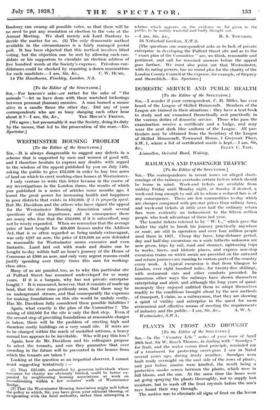WESTMINSTER HOUSING PROBLEM [To the Editor of the SPECTATOR.]
Sra„—It is always disagreeable to suggest any defects in a scheme that is supported by men and women of good will, and I therefore hesitate to express any doubts with regard to the wisdom of the appeal published by you on July 14th, asking the public to give £32,000 in order to buy two acres of land on which to erect working-class houses at Westminster.
I only venture to write this letter because in the course of my investigations in the London slums, the results of which you published in a series of articles some months ago, I learnt the great power for increasing health and happiness in poor districts that exists in £32,000, if t is properly spent. But Mr. Davidson and the others who have signed the appeal for the "WeStminster Housing Association omit several questions of vital importance, and in consequence there are many who fear that the £32,000, if it is subscribed, may not be wisely expended. When we remember that the average price of land bought for 400,000 houses under the Addison Act, that is so often regarded as being unduly extravagant, was only £187 an acre, the price of £16,000 an acre defended as reasonable for Westminster seems excessive and even
fantastic. Land laid out with roads and drains can be bought to-day within half an hour's journey of the House of Commons at £500 an acre, and only very urgent reasons could justify spending over thirty times this sum for working- class sites.
Many of us are puzzled, too, as to why this particular site at Pulford Street has remained undeveloped for so many years. If it is a bargain, why has not private enterprise bought ? It is rumoured, however, that it consists of made-up land, that the river runs perilously near, that there may be an underground stream, and that consequently the expenses for making foundations on this site would be unduly costly. Has Mr. Davidson fully considered these possible liabilities ?
Again, what exactly is the plan of the Committee ? The raising of £32,000 for the site is only the first step. Even if the second step of providing foundations at reasonable charges
is taken, there' will be the problem of erecting high and therefore costly. buildings on a very small site. If rents are
to be charged within the reach of unskilled artisans, a heavy annual loss appears to be inevitable. Who will pay this loss ? Again, how do 'Mr. Davidson and his colleagues propose to select the tenants, and can they guarantee that over crowding in the future will be prevented in the houses from which the tenants are taken ?
Looking at the question as an impartial observer, I cannot
resist suggesting tentatively :— (1) That £32,000, subscribed by generous individuals whose resources for charity are obviously limited, could be better ex- pended by neighbouring • housing associations at work on reconditioning within a few minutes' walk of Westminster Bridge.
(2) That the Westminster Housing Association might well follow the.policy to- which, Sit, you have pren your editorial blessing, of co,operating• *rith:_the local authority, rather. than . attempting a scheme which appears, on the evidence so far given to the public, to be unduly wasteful and badly thought out.
53 Netherhall Gardens, N.W.3.
[The questions our correspondent asks as to lack of private enterprise i in developing the Pulford Street site and as to the " exact plan of the Committee " are, we think, reasonable and pertinent, and call for reasoned answers before the appeal goes further. We must also point out that 'Westminster, with its rating powers, has no sound plea for the charity of the London County Council at the expense, for example, of Stepney. and Shoreditch.—En. Spectator.]




































 Previous page
Previous page